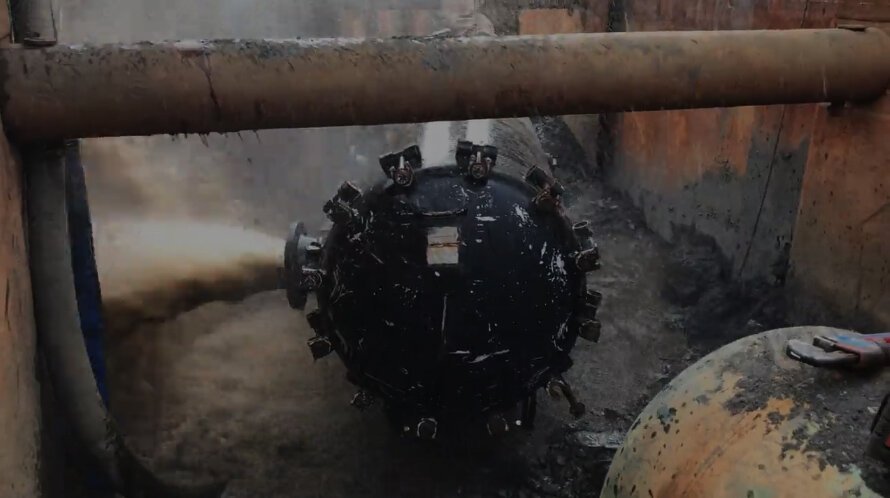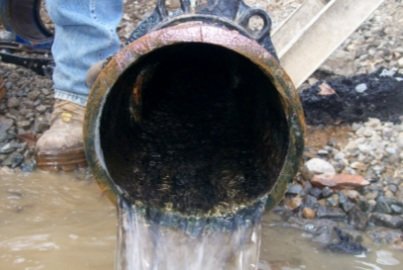
Dewatering
Pipeline dewatering is one of the most important and technically challenging steps in preparing a pipeline for service. After hydrostatic testing, every drop of water must be removed to prevent corrosion, protect product quality, and ensure the line is safe for inspection and operation. At American Pipeline Solutions (APS), we perform dewatering with precision, safety, and efficiency, drawing on decades of experience and advanced pigging technology.
What Is Pipeline Dewatering?
Pipeline dewatering is the process of expelling water from the inside of a pipeline, typically after hydrotesting or construction. During a hydrotest, the line is filled with water and pressurized to confirm strength and integrity. Once this step is complete, water must be displaced and safely discharged.
Unlike other fluids, water cannot be compressed. When compressed air is used to drive a pig through the line, pockets of air form ahead of the pig, creating sudden and forceful discharges at the receiving end. This makes dewatering one of the highest-risk procedures in pre-commissioning. APS technicians are trained to anticipate these risks and apply strict safety controls so the process is completed without incident.
Once a hydrotest has been completed, the same pig as was used to fill the line will be run back to the launch site utilizing compressed air. Pipeline dewatering can be one of the most dangerous procedures in the pre-commissioning process. This is due to the fact that air is compressible and water is not; large air pockets develop in front of the dewatering pig creating violent releases of air/water at the terminus. APS Technicians monitor the pig as it dewaters so that valves and piping at the release point maintain a constant backflow pressure to minimize danger to both personnel and equipment. Once pipeline dewatering is complete the drying process can commence.
Why Dewatering Matters?
Dewatering is not simply a mechanical step—it is essential for long-term pipeline health and operational readiness.
Corrosion prevention: Water left in the pipeline after hydrotesting accelerates corrosion, especially when non-potable water has been used.
Cold climate protection: In freezing environments, residual water can turn to ice, causing blockages or even ruptures.
Product purity: For oil, gas, water, or industrial systems, even trace moisture can contaminate the product, reduce efficiency, or damage equipment.
Inspection readiness: A dry line is necessary for accurate smart pigging, condition analysis, and internal coating applications.
Compliance and safety: Regulatory standards and operational best practices require pipelines to be dewatered and dried to specific criteria before entering service.
APS’s Dewatering Process
At APS, every dewatering operation is tailored to the pipeline’s size, length, location, and service requirements. While the principles are consistent, execution is carefully adapted to each project.
Post-hydrotest preparation – Once testing is complete, the dewatering pig (often the same pig used to fill the line) is inserted.
Pig propulsion – Compressed air, dry gas, or nitrogen is used to drive the pig through the line, displacing water as it travels.
Continuous monitoring – Technicians track pig location and velocity while monitoring backpressure to control air/water discharge at the outlet.
Controlled discharge – At the receiving end, valves and piping are managed to maintain safe backflow pressure and minimize surges.
Verification – Water removal is confirmed before drying methods are applied.
By maintaining strict control over flow dynamics, APS minimizes risk to personnel, equipment, and the environment.
Safety: Our Top Priority
Dewatering presents unique hazards that demand expertise. Air pocket compression can cause explosive releases of energy if not properly managed. Launch and receiving facilities must be engineered to handle rapid flow changes, while technicians must remain vigilant at every step.
APS technicians follow industry-recognized procedures and apply real-time monitoring to detect pressure fluctuations. By combining technology with experience, we reduce the chance of uncontrolled releases and keep teams safe. This commitment to safety has made APS a trusted partner for pipeline operators nationwide.
From Dewatering to Drying
Dewatering is the foundation of the drying process. Once water is removed, APS prepares the pipeline for service by achieving the required dryness or dew point. Depending on project requirements, we may use dry compressed air, nitrogen, vacuum drying, or a combination of methods.
Proper drying not only prevents corrosion but also ensures that pipelines meet strict specifications before product is introduced. For certain systems, we can also follow with internal pipe coating to further extend service life and protect against corrosion.
Why Choose APS for Pipeline Dewatering?
Specialized expertise: Dewatering is one of the most complex steps in pre-commissioning. APS’s trained technicians have years of field experience in high-risk operations.
Advanced technology: From pig tracking systems to pressure control equipment, APS uses proven methods and tools to keep projects safe and efficient.
Commitment to safety: Our procedures are designed to eliminate unnecessary risk, protecting both personnel and infrastructure.
Comprehensive solutions: APS doesn’t just dewater pipelines—we provide full pre-commissioning services including pigging, inspection, condition analysis, drying, coating, and mapping.
Trusted reputation: As a member of the Pigging Products & Services Association (PPSA), APS meets global standards for pipeline service quality.
Work With APS
American Pipeline Solutions provides dewatering services across the United States, supporting oil, gas, water, and industrial pipelines of every size. Whether your project involves a new installation or routine maintenance, we bring the expertise and equipment to deliver safe, timely, and cost-effective results.
Contact APS today to schedule a consultation and ensure your pipeline is dewatered, dried, and ready for service.


















